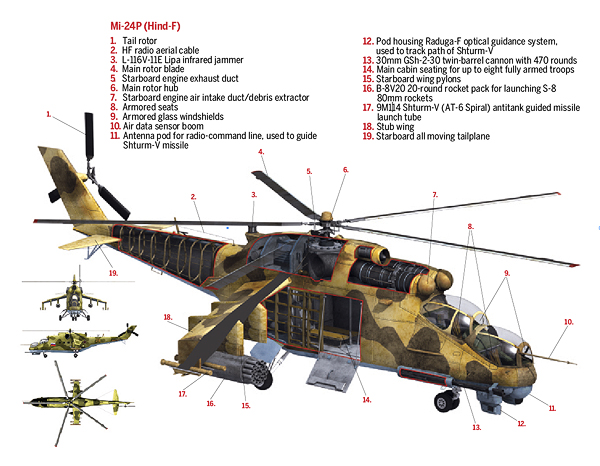
In the early 1960s the Soviet Union sought a helicopter capable of carrying an assault element of soldiers into battle and providing them with close air support. To satisfy that requirement, in 1966 Mikhail Mil developed a large, formidable assault helicopter like no other in the world. The new design gained worldwide attention on Sept. 21, 1978, when test pilot Gurgen Karapetyan flew a cleaned-up Mi-24A-10 at 199.13 knots (228.9 miles per hour), a helicopter speed record that stood for eight years.
The Mi-24A (codenamed Hind-A by the North Atlantic Treaty Organization) entered Soviet service in 1970. Its large glazed canopy and side-by-side seating for the pilot and his weapon systems officer (WSO) raised myriad criticisms from its crews, which the design bureau (Mil himself had since died) quickly addressed. The Mi-24B introduced a USPU-24 turret with a YakB-12.7mm four-barreled machine gun and an improved antitank guided missile system. The Mi-24D introduced the distinctive Hind-D configuration of separate armored cockpits, with the WSO up front.
Although the Mi-24 was best known for supporting Soviet forces in Afghanistan—and suffering heavy losses to the U.S.-supplied Stinger surface-to-air missiles used by the mujahedeen—it saw first use by Ethiopia in its 1977–78 war with Somalia. Since then Hinds have provided air support for the forces of Vietnam, Iraq, Libya, Syria, Nicaragua, Peru, Croatia, Yugoslavia and Macedonia. After the breakup of the Soviet Union, the Cold War gave way to numerous hot wars, most notably Chechnya, in which many Mi-24 variants came into play.
In the 1980s the Mi-24V (Hind-E) and its export version, the Mi-35, appeared, with a 2,225-shp TV3-117V engine, better avionics, an improved ASP-17V automatic gunsight and a wider array of armament, including R-60 (AA-8 Aphid) air-to-air missiles. For added punch the similar Mi-24P (Hind-F) replaced the flexible forward YakB-12.7 machine gun with a fixed 30mm GSh-2-30 twin-barrel cannon.
The most widely used of all Hind variants, the Mi-24V and Mi-35 are still in limited production. Upgrades in power, agility, avionics, fire control and weaponry, implemented not only by Mil in Russia but also by companies in Israel, South Africa and France, have produced new Hind breeds that are deadlier than ever.




